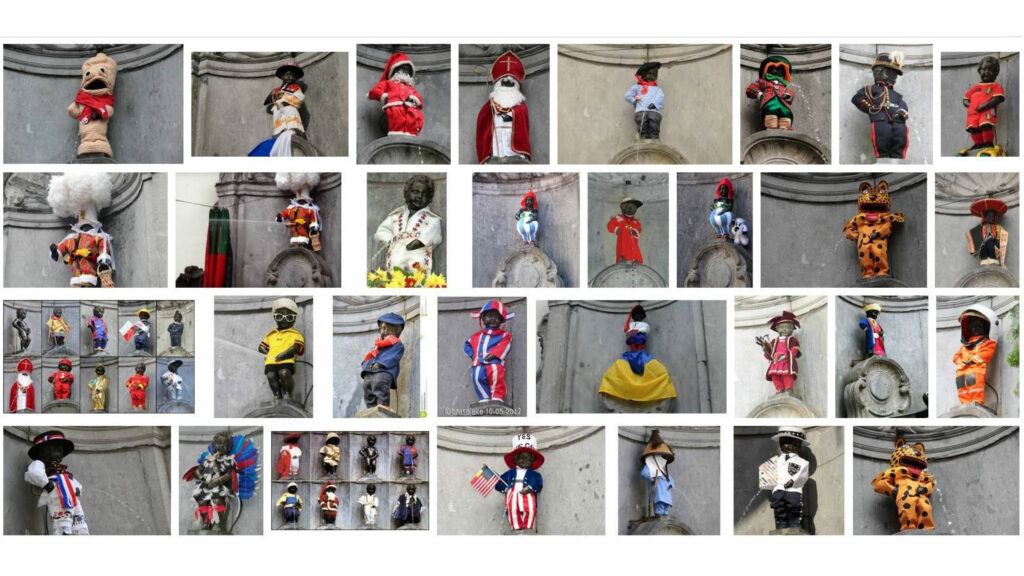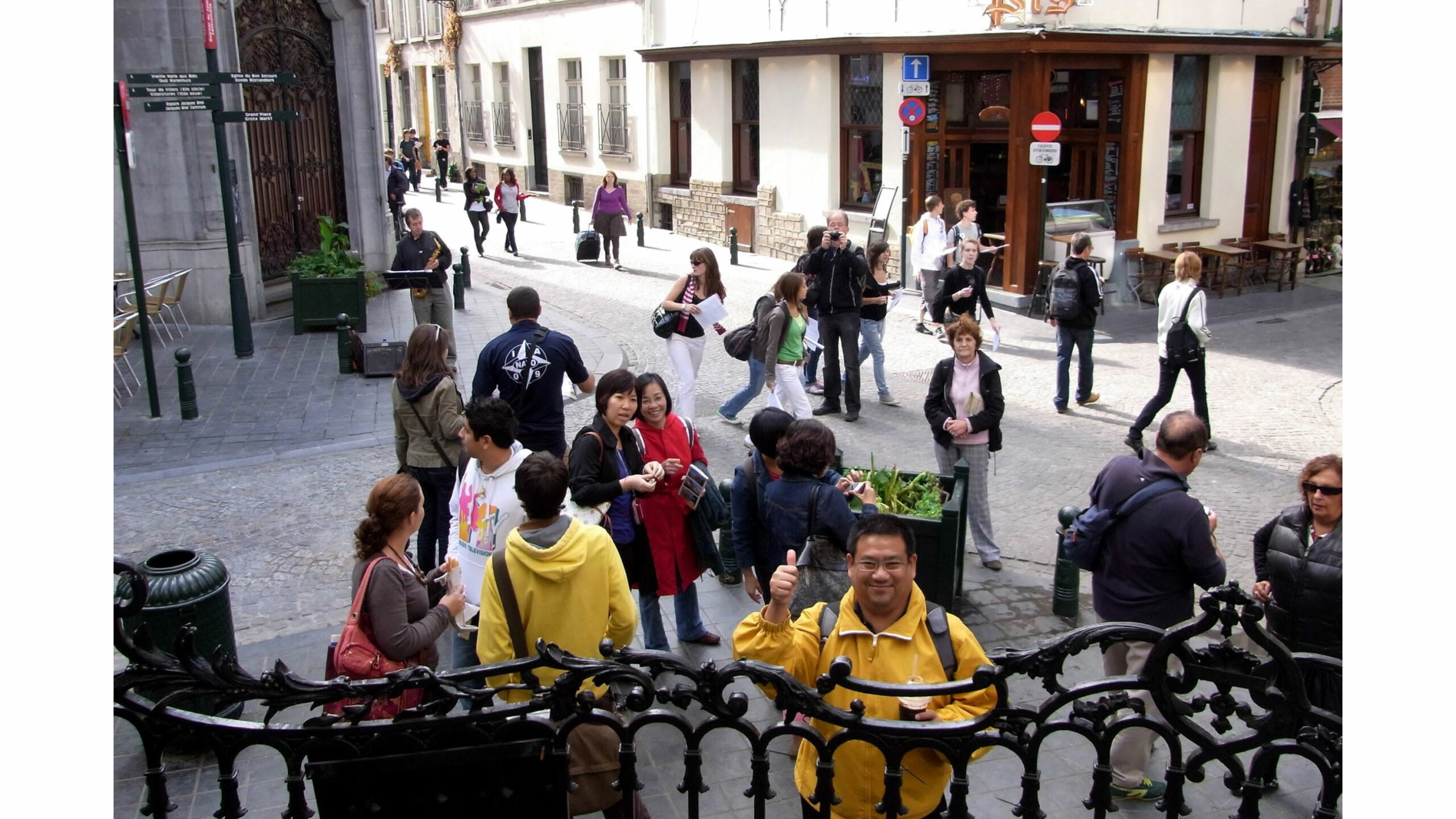Manneken Pis: May I take your picture ?




PISSING IN THE WIND by FELIX MADRAZO (2009)
Stephane Damsin revealed us recently with his exhibition and photo book ‘This pictures are not made by me, but could have been’ something quite critical at first glance, the latent imbecility of each of us human to take a photo of ourselves in front of those places we ‘must see before we die!’ Yet Stephane himself travelled to those places also and surely enjoyed the trip just like any of the tourists did before him, so his work is not a direct sarcastic criticism; his imbedded humbleness in everything he does places the questions in both directions always, to the public in general but above all to himself. He is brave enough to admit that we are all somehow destined to follow the steps of millions before us, but on top of that he wants to be aware of it at all times! Oof! Heroic!
The dream of individuality has marked the last centuries with many patterns and dreams, political options and their resulting counterparts. But above all it has been a Sisyphus fight against anonymity and repetition. Tourism for the masses, houses for the masses, music for the masses, all have to supply and succeed in portraying precisely the opposite, the idea that we are unique customers, each of us irreplaceable human entities constructing our own distinct ‘profile’. Each house with a garden recreates the individual dream; each playlist in our ipod makes us different and unique and interesting for others, each picture taken in our holidays demonstrates that it is crucial for most of us to document our own life like Sinatra, to show later which was ‘our’ way, we are individual memory, without it we are not humans we fear.
In any case Facebook has proved Warhol wrong; we struggle today not to be world famous for 15 minutes but instead to be famous to 15 people. We inform each of them where we are, where we are moving towards to, what event we are attending, which is our mood, not that they asked for it – perhaps they don’t even read our ‘status’ as often as we hope – but we take the effort to record nevertheless, who knows maybe somebody is really interested, it seems worth the titanic effort to document, to write down painstakingly our path everyday and make it public to them, our 15 fans, and even better if photos support it.
My wiki knowledge is that Manneken Pis has been dressed in many costumes, it has been stolen and remade, it even has a sister, a Janneken piss in Brussels also, the Manneken pis of Brussels might not even be the first one, as some other places claim to have an oldest version. Even the origin or reason of being is still in dispute. Manneken pis nevertheless has managed to captivate millions of us. Being near him has proved to be more important than to visit Brussels museums including this house for sure. Visiting him is culture, photographing him our evidence of being part of it. Would anyone dare to say no here?
So why put a camera on him? Manneken pis empowerment? Justice at last? No! Stephane has done something different, he has made us realize for the fraction of a second -while it sounds click- that perhaps we are all mannekin pis, he’s our own mirror, our own self being documented! The few persons lucky enough to see him holding the camera have taken a precious moment none of the millions of tourist got before, a nude portrait of themselves pissing in the wind, now that is a mastercard moment at last! Priceless!



Tourist Yourself! by Daniel Vander Gucht, sociologue, professeur à l’université libre de Bruxelles, October 2009
In a little book, to be read during a train or plane journey, Ecce homo touristicus (sub-titled « Identity, memory and heritage in an era of the world-wide museum » (Brussels Labor, 2006), I evoked what seemed to me to be our progressive but irresistible transformation into tourists of our own culture – this mutation of our own human condition to that of homo touristicus as such contributes to create what I would call the patrimonial syndrome. This patrimonial syndrome seems to seal the destiny of the museums of the world and maintain the tourist industry – it results in the colonization of the cultural domain which in turn leads to cultural heritage and museums becoming indispensable assets of the tourist industry.
We continue however to flatter ourselves that we are travellers – the aristocracy of gregarious movement and seasonal exodus – or citizens of the world – a democratic and world-wide version of « a man of the world », reserving our mocking condescension for the tourist, who is always someone else. In each tourist however there lies a degree of curiosity that awakens to the reality of the world as it is. And, if no-one appears to regret the heroic past of explorers and adventurers, declaring that each journey is therefore impossible, we could respond to them by saying that aventure is always just around the corner, in as much as we remain open to the world and to the emergence of the unknown, to ordinary encounters with others – where indeed nothing is ordinary. To this end, the simple tourist proves to be an easy scape-goat. This inclination of the modern man remains – this homo touristicus – to become a tourist of his own existance, a spectator of his own memory.
Mass tourism in part linked to the museum as with photography (which allows the inhabitant the apparition of the imaginary Museum, dear to André Malraux). But the museum, as with photography, is a pretext to help us to see better and to better remember, but does it not in reality dispense us from looking and exercising our memory as a cultural tourist, trained to recognize rather than know and to gather pictures of the world rather than becoming involved? In terms of being elsewhere, the tourist, onlooker rather than traveller, even though he still dreams of adventure, seeks to recognize typical cliches, proposed by post cards and picture books from his childhood. It is the reproduction and repetition of this exotic emotion that the tourist seeks by means of his his quest for « authentic scenery », and not a meeting with reality or the truth of a country, its people or a living culture. The tourist, that we all are, travels in reality to recognize places and views seen in magazines, catalogues, on the television or the cinema, in exactly the same way as one goes to the museum to confirm that the originals match their copies.
This touristic experience in a deferred and mediatic world through photographs of views is further multiplied by the numeric fever, which no longer requires that one travels the world in search of such views, when avatars of ourselves take care of presenting them via Internet, posing in a convincing and casual manner in front of views and sites recognized through just a glimpse of our collective memory. A stranger to himself, far from the « I am another » by Rimbaud (although ……), the ultimate tourist may indeed take himself to be another, as presented by Stéphane Damsin with his « album souvenir », entitled « Me on Holidays or Alter est Ego », where deterioration is cancelled out through the virtual interchange and repetition of the same. And, through this gap between the relationship as one looks on faced with these crowds of tourists who are literally trying to make the world disappear behind a blinding multitude of pictures, and that of the blind tourist mechanically perpetuating himself in a rituel of elimination of the world through insignificant photographis, which in turn become an object of observation, surveillance and control. In other words, what appears to be, without seeming to have been addressed, and with an economy of means, the mechanism imagined by the same Stéphane Damsin in his new project, May I take your picture?





Manneken Pis: May I take your picture ?
Year: 2009
Status: Archive
Program: Whatever
Location: Brussels, Belgium
MAY I TAKE YOUR PICTURE ? MANNEKEN-PIS PRESENTS HIS VISION OF IT ALL
To change Manneken Pis into a photographer for a day starts with a reflection about today’s tourist and the frantic, sometimes excessive, relationship with the digital camera. With the web 2.0, when one can find photos of everything on Internet (and certainly those of Manneken Pis), why then during our travels do we still seek to take our ‘own’ photograph of the most famous sites and monuments? What importance do we give to the moment, the experience of a specific place, when we are not looking at it through the eye of the camera?
In the case of famous tourist sites, when everyone next to us is taking the same photo, it is unlikely that ours will be original or exclusive. Although we are aware of our vanity in thinking so,
we still take our own shot. A sort of ‘I was there’ expressing our need for approval, proof and as a trophy. More than being critical, it is an open question we ask here of ourselves with self-mockery and humour. A will to change places for an instant and, in the role of a tourist, see the relationship we hold with a place and the moment in time. The camera that Manneken Pis is holding takes real photos. A selection of the snapshots taken will be shown at the exhibition dedicated to this work from November 5th – 22nd, 2009 at the ‘Maison du Folklore’.
CONCEPT : Stephane Damsin
AUTHORS TEXTS : Stephane Damsin + Daniel Vander Gucht + Felix Madrazo
SUPPORTED BY :
Service Culture de la Ville de Bruxelles / Philippe De Rouck + Nicolas Edelman + Pascale Salesse
CAMERA BOX REALISATION : Wolfgang Bregentzer
INDEPENDANT FLASH REALISATION : Robin Marsily
TECNICAL SUPERVISATION : Daniel Diaconescu
MOVIE REALISATION : François Chandelle
PHOTO CAMERA SUPPORT AND ADVICE : Photosphère
TRANSLATIONS : Jacqueline Sanspeur + Chantal Van Acker + Grazia Clare
PRESS RELAY : Katie Van Hemelrijck
PRINTING : Atelier KZG + Photosphère sprl
SPECIAL THANKS : Antonio Nardone (for his accurate comments and advices) + Nicolas Damsin + Christophe Brigode + Laure Greban + My family and friends + Supersudaca